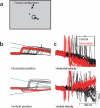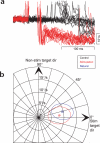Serial linkage of target selection for orienting and tracking eye movements
- PMID: 12145637
- PMCID: PMC2548313
- DOI: 10.1038/nn897
Serial linkage of target selection for orienting and tracking eye movements
Abstract
Many natural actions require the coordination of two different kinds of movements. How are targets chosen under these circumstances: do central commands instruct different movement systems in parallel, or does the execution of one movement activate a serial chain that automatically chooses targets for the other movement? We examined a natural eye tracking action that consists of orienting saccades and tracking smooth pursuit eye movements, and found strong physiological evidence for a serial strategy. Monkeys chose freely between two identical spots that appeared at different sites in the visual field and moved in orthogonal directions. If a saccade was evoked to one of the moving targets by microstimulation in either the frontal eye field (FEF) or the superior colliculus (SC), then the same target was automatically chosen for pursuit. Our results imply that the neural signals responsible for saccade execution can also act as an internal command of target choice for other movement systems.
Figures







Comment in
-
Pursuing commitments.Nat Neurosci. 2002 Sep;5(9):819-21. doi: 10.1038/nn0902-819. Nat Neurosci. 2002. PMID: 12196803 Review. No abstract available.
Similar articles
-
Discharge properties of neurons in the rostral superior colliculus of the monkey during smooth-pursuit eye movements.J Neurophysiol. 2000 Aug;84(2):876-91. doi: 10.1152/jn.2000.84.2.876. J Neurophysiol. 2000. PMID: 10938314
-
Neuronal activity in the rostral superior colliculus related to the initiation of pursuit and saccadic eye movements.J Neurosci. 2003 May 15;23(10):4333-44. doi: 10.1523/JNEUROSCI.23-10-04333.2003. J Neurosci. 2003. PMID: 12764122 Free PMC article.
-
Dissociation of pursuit target selection from saccade execution.Vision Res. 2012 Dec 1;74:72-9. doi: 10.1016/j.visres.2012.09.006. Epub 2012 Sep 26. Vision Res. 2012. PMID: 23022138 Free PMC article.
-
Neural mechanisms underlying target selection with saccadic eye movements.Prog Brain Res. 2005;149:157-71. doi: 10.1016/S0079-6123(05)49012-3. Prog Brain Res. 2005. PMID: 16226583 Review.
-
Causal Role of Neural Signals Transmitted From the Frontal Eye Field to the Superior Colliculus in Saccade Generation.Front Neural Circuits. 2018 Aug 28;12:69. doi: 10.3389/fncir.2018.00069. eCollection 2018. Front Neural Circuits. 2018. PMID: 30210307 Free PMC article. Review.
Cited by
-
Inactivation and stimulation of the frontal pursuit area change pursuit metrics without affecting pursuit target selection.J Neurophysiol. 2011 Jul;106(1):347-60. doi: 10.1152/jn.00669.2010. Epub 2011 Apr 27. J Neurophysiol. 2011. PMID: 21525365 Free PMC article.
-
Neural activity in the frontal pursuit area does not underlie pursuit target selection.Vision Res. 2011 Apr 22;51(8):853-66. doi: 10.1016/j.visres.2010.10.010. Epub 2010 Oct 21. Vision Res. 2011. PMID: 20970442 Free PMC article.
-
Saccades exert spatial control of motion processing for smooth pursuit eye movements.J Neurosci. 2006 Jul 19;26(29):7607-18. doi: 10.1523/JNEUROSCI.1719-06.2006. J Neurosci. 2006. PMID: 16855088 Free PMC article.
-
Role of the lateral intraparietal area in modulation of the strength of sensory-motor transmission for visually guided movements.J Neurosci. 2012 Jul 11;32(28):9745-54. doi: 10.1523/JNEUROSCI.0269-12.2012. J Neurosci. 2012. PMID: 22787060 Free PMC article.
-
Attention governs action in the primate frontal eye field.Neuron. 2007 Nov 8;56(3):541-51. doi: 10.1016/j.neuron.2007.09.029. Neuron. 2007. PMID: 17988636 Free PMC article.
References
-
- Glimcher PW. Making choices: the neurophysiology of visual-saccadic decision making. Trends Neurosci. 2001;24:654–659. - PubMed
-
- Schall JD. Neural basis of deciding, choosing and acting. Nat. Rev. Neurosci. 2001;2:33–42. - PubMed
-
- Keller EL, Heinen SJ. Generation of smooth-pursuit eye movements: neuronal mechanisms and pathways. Neurosci. Res. 1991;11:79–107. - PubMed
-
- Wurtz RH, Goldberg ME. The Neurobiology of Saccadic Eye Movements. Elsevier; New York; 1989.
-
- Glimcher PW, Sparks DL. Movement selection in advance of action in the superior colliculus. Nature. 1992;355:542–545. - PubMed
Publication types
MeSH terms
Grants and funding
LinkOut - more resources
Full Text Sources
Other Literature Sources

